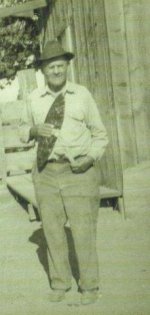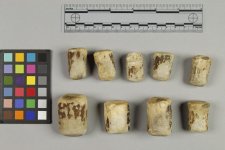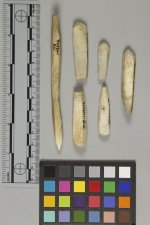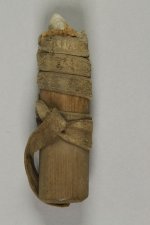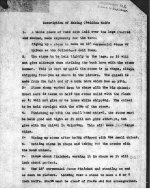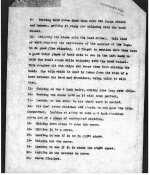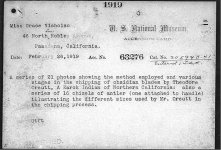For those who are interested in authentic New World flintknapping technologies, the tool recorded by soldier P.H. Ray, when he was stationed among the Hupa of northern California, was finally recovered, and posted online by a national museum.
This tool was shown in the Columbia Exposition, during the 1890's, along with the rest of the flintknapper's toolkit.
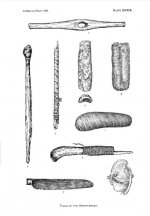
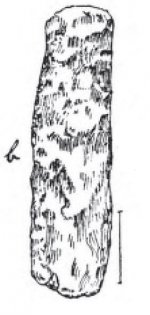


Ray writes:
1885 - "The methods of the northern Californian bowyer and fletcher are now pretty clearly understood. For ordinary flaking of jasper or obsidian he uses a common pebble hammerstone, but for detaching flakes of the best quality he uses between his hammer and his core a "PITCHING TOOL" or sort of "COLD-CHISEL" of the hardest antler." ("Ray Collection From Hupa Reservation", P.H. Ray)
Fig. 5 - The Pitching Tool - A COLUMN OF ANTLER used like a COLD CHISEL in knocking off SPALLS or FLAKES or BLADES by means of some kind of hammer.
The ubiquitous presence of tools of indirect percussion was further confirmed by Professor Otis Tufton Mason, during the 1890's, when he wrote:
"Lieut. Kay was the first to actually send to the National Museum a bit of antler, 6 inches long and about three quarters of an inch in diameter, to be used like a stonecutter's punch or "pitching tool" or a smith's punch in knocking off chips in the process of arrow-making. But there are constant references to this intermediary tool. The writer, who has experimented in most aborginal stone-working methods, has not attempted to use this apparatus in order to know its limits." ("North American Bows, Arrows, and Quivers, Otis Tuft Mason)
This tool was shown in the Columbia Exposition, during the 1890's, along with the rest of the flintknapper's toolkit.




Ray writes:
1885 - "The methods of the northern Californian bowyer and fletcher are now pretty clearly understood. For ordinary flaking of jasper or obsidian he uses a common pebble hammerstone, but for detaching flakes of the best quality he uses between his hammer and his core a "PITCHING TOOL" or sort of "COLD-CHISEL" of the hardest antler." ("Ray Collection From Hupa Reservation", P.H. Ray)
Fig. 5 - The Pitching Tool - A COLUMN OF ANTLER used like a COLD CHISEL in knocking off SPALLS or FLAKES or BLADES by means of some kind of hammer.
The ubiquitous presence of tools of indirect percussion was further confirmed by Professor Otis Tufton Mason, during the 1890's, when he wrote:
"Lieut. Kay was the first to actually send to the National Museum a bit of antler, 6 inches long and about three quarters of an inch in diameter, to be used like a stonecutter's punch or "pitching tool" or a smith's punch in knocking off chips in the process of arrow-making. But there are constant references to this intermediary tool. The writer, who has experimented in most aborginal stone-working methods, has not attempted to use this apparatus in order to know its limits." ("North American Bows, Arrows, and Quivers, Otis Tuft Mason)
Amazon Forum Fav 👍
Upvote
0


